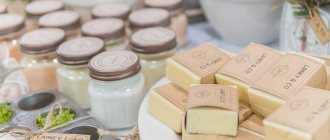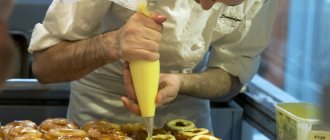Opening your own chocolate business is not difficult, and the profitability can exceed expectations. The main thing is to correctly construct the technological process and obtain the necessary permits from regulatory authorities. In conditions of oversaturation of the market with mass-produced chocolates of the same type, exclusive chocolates will definitely find their connoisseurs and buyers.
Sweets are always in demand, and chocolate is also a popular gift that suits any occasion. The technology for making chocolate is simple - you can even make it at home.
Handmade chocolate
Making handmade chocolate allows you to realize any fantasies of the confectioner and customers. Now the market is overflowing with stereotyped, identical candies, so unique chocolate products produced in small quantities or only to order are sure to attract attention. Chocolate, as a raw material, gives a lot of scope for imagination.
You can not limit production to just one product, for example, chocolate bars, but diversify it with gift and souvenir products or unusual candies. You can use additives, including those that significantly reduce the cost of production, for example, carob. Try experimenting with different fillings. Fans of original flavors will appreciate chocolate with salt, pepper, popcorn or salted caramel. You can constantly expand your assortment and thereby attract new customers.
In India, old buses are being converted into food trucks
Make shopping lists: how smart spending saves your wallet and nerves
Business, career, money: horoscope for all zodiac signs for the week 09/28–04/10
Chocolate making business ideas
Chocolate production involves two forms of business organization:
- home;
- industrial.
Making chocolate at home involves small sales volumes. The confectioner collects orders from private clients, after which he prepares batches of the product. The equipment is a stove and a refrigerator. From a legislative point of view, this activity is not considered a business, since it does not meet the requirements for production premises.
Industrial production of chocolate is located in a separate workshop. This includes purchasing equipment, hiring staff, and maintaining financial records. The costs of industrial production are several times higher than home production and are recouped through increased sales.
Making handmade chocolate
Selling handmade chocolate is a new business area for the Russian market. The first large chocolate boutiques began to appear in 2020. Their assortment consisted of products that were made according to unique home recipes. Due to the originality of handmade chocolate and selected ingredients, it is considered elite.
Boutiques do not compete with chocolate factories in terms of production and sales volumes. But they compensate for the smaller quantity of goods with quality. The “menu” of chocolate boutiques consists of several standard items:
- chocolate bars in bars (dark, milk or white);
- bar chocolate with filling (fruits, nuts, etc.);
- truffles;
- chocolate candies with filling.
Since chocolate is often bought as a gift, boutiques provide gift packaging. They contain several types of chocolate. Home production also allows you to create custom bars and candies. The customer chooses the design, engraving and quantity of goods.
One way to appeal to your target audience is to create gourmet chocolate. Chocolate boutiques are actively experimenting with unusual and even “shocking” combinations of flavors. Examples of such combinations include chocolate with bacon, chilli and absinthe. Other interesting ingredients often used include:
- ginger;
- candied fruit;
- flower petals;
- meadow grass.
Making fruits in chocolate
Fruits in chocolate glaze are an unusual dessert for the Russian audience. The reason for the low popularity of this product is that large chocolate companies do not take up this idea. The production of such goods is expensive - due to the cost of the fruit itself and their limited shelf life. Therefore, entrepreneurs who want to develop in this area will face two features:
- extremely low level of competition on the Russian market;
- unformed target audience.
Strawberries, bananas, apples, and pears are used as base fruits. The business of producing such sweets is associated with two main problems:
- The studio will need a permanent reliable supplier. The quality of fruit in chocolate is determined not only by the chocolate, but also by the fruit itself. Even the best chocolate cannot “save” a tasteless berry or a dry apple.
- atelier will depend on seasonality. The number of chocolate-covered fruits produced is determined by market supply. It is impossible to get juicy and sweet strawberries all year round at the same price. We have to give up certain items or increase purchasing costs.
Reference. The main advantage of an entrepreneur is the “trump card” in the form of the usefulness of the product. Fruits covered in chocolate are the perfect combination of tasty and healthy. If a chocolate studio is located in a shopping center, then the businessman will be able to increase sales to a high level. If the opening of a point is accompanied by a competent advertising campaign.
Making chocolate figures
A chocolate shop that specializes in creating figurines must have its own concept. The development of the store’s assortment determines how successful sales will be. To compile a “menu” you will need an analysis of competitors. Companies that make figurines offer the following product categories:
- themed souvenir figures;
- shaped candies;
- chocolate figures to order;
- chocolate cards;
- chocolate portraits.
Making chocolate at home is distinguished by its simplicity. The process consists of several stages:
- molds are filled with hot chocolate;
- the forms are cooled until the substance hardens;
- the chocolate shell is cut into two parts and removed;
- the edges of the parts are heated and glued to each other.
To create unusual products, confectioners combine different types of chocolate and add food coloring. It is also necessary to think over the store’s pricing policy. The assortment should consist of both expensive and budget products. Inexpensive figures will attract the attention of interested buyers. If they are satisfied with the taste of the chocolate, they will soon return for more purchases.
Today, chocolate figurine stores operate according to two schemes:
- purchasing products from different manufacturers and selling them;
- sales of home-made products.
Business owners who take over the production of chocolate have one significant advantage. They can take individual orders from clients, which are often timed to coincide with festive events - a wedding anniversary, the anniversary of the opening of a company, etc.
Fruits and berries in chocolate
Juicy fruits in chocolate glaze are a favorite dessert of adults and children. Chocolate perfectly emphasizes the natural aroma of fruits, and they, in turn, significantly enrich the taste and aroma of cocoa beans. These candies have moderate sweetness and will appeal even to those who support a healthy lifestyle. After all, the vitamins in the fruit are preserved during the production process, and the glaze layer is very thin - this is an important argument for those who care about their figure and adhere to a healthy diet. The only negative is that such sweets have a short shelf life.
It is best to make them to order in small batches, which will immediately go to the customer. Chocolate-covered fruits are an excellent decoration for a buffet table or candy bar; they are suitable for a corporate evening or a children’s birthday. Therefore, they can be safely offered not only to private clients, but also to companies involved in organizing holidays.
Competition is high in the fashion capital of London, but young designers have persevered
Funny incidents from the history of world brands: why Ikea is called that
Why working hours? Rules I recommend breaking when working remotely
History of chocolate
Chocolate has been known to people since ancient times. Each of us has tried a bar of this delicate delicacy at least once in our lives, and some cannot even imagine life without chocolate. If we open the culinary encyclopedia, we will see the following definition:
Chocolate is a finished confectionery product made using cocoa powder or cocoa butter, as well as other ingredients that improve the taste and aroma of the product and give it a delicate texture.
However, chocolate did not always have the familiar bar form. The first chocolate began to be made more than three thousand years ago in Latin America. The Mayan Indians figured out how to grind the fruits of the Theobroma cacao tree into a fine powder, mix them with hot peppers and sweet corn, and make a drink from this mixture. It was this “chocolatl,” as the Indians called it, that became the progenitor of modern chocolate.
Of course, chocolate making technology has undergone major changes since then. From Latin America it reached Europe, where for a long time it was valued more than gold. It was then that the first attempts were made to build a chocolate business. Cocoa beans were incredibly expensive, so making a chocolate drink could literally make a confectioner rich. The production itself was also expensive, since cocoa beans had to be crushed manually. In addition, chocolate was stored very little at that time.
But chocolate production technologies developed, and at the end of the 19th century it acquired the familiar “slab” appearance. Making chocolate is still unthinkable without grated cocoa beans and cocoa butter. But in addition to this, the recipe often includes sugar, milk or cream, coffee, alcohol, cognac, vanillin, as well as nuts, candied fruits, dragees, waffles, and various dried berries. Currently, chocolate with unusual additives, such as salt, is becoming especially popular.
Chocolate figures
The plasticity of chocolate, its ability to take different shapes and even change color, allows you to create candies with an original design. Chocolate figurines are an unusual gift and another promising direction for your own sweet business. You can make themed souvenir figurines, for example, for the holidays - chocolate flowers for March 8, Christmas trees for the New Year, skulls and pumpkins for Halloween, and so on. It is enough to purchase suitable forms.
The figures can be made of solid chocolate, hollow, or with fillings. It all depends on your imagination and production capabilities. Original chocolate gifts are in demand - for example, chocolate portraits or candies with corporate symbols.
Marketing ploys that force women to buy alcohol for themselves
How to buy an inexpensive car in Germany: traders in the northwest and Swabia are more reliable
Dacha for ordinary people: 6 million rubles for one average house in Yamal
What are different types of chocolate made of?
A huge variety of products are made from cocoa products. But the food industry has adopted a general classification for the convenience of confectioners:
- Plain chocolate with or without additional ingredients. The base consists of grated cocoa, butter and powdered sugar. If there is a lot of cocoa butter (60-80%), then such chocolate is called bitter, if there is less than the specified amount, then simply black.
- Dessert, to which additional ingredients can be added or dispensed with. If the chocolate mass contains any additives other than the main 3 ingredients, then it becomes dessert.
- White. A very tasty sweet substance that professional confectioners do not call chocolate. If you figure out what white chocolate is made from, then the reason for this will become clear. There is no chocolate component in it, there is only cocoa butter.
- Special purpose. Certain groups of consumers need to make chocolate using a different recipe from the main one. For example, diabetics eat chocolate with sugar substitutes, and athletes eat chocolate enriched with vitamins and microelements.
- Lactic. According to recipes, it contains a significant amount of dry dairy products (whey, cream or milk). The result is a very tasty sweet treat with caramel flavors.
- Porous. Almost every confectionery factory boasts its own type of aerated chocolate - black, white or milk.
Important! Additional ingredients include nuts, dried fruits and other delicacies that enrich the taste of the bar in colorful packaging. They cannot be called harmful sweeteners and additives.
How to register a business
Regardless of whether a person plans to open a large or small production workshop, his own store, cafe, or sell goods online, registration with the tax office is required. Depending on the expected volumes and the presence of co-founders, you can form an individual entrepreneur or LLC. Wholesalers and suppliers are more willing to cooperate with the latter.
When registering, you can specify the following OKVED codes: 15.84, 52.61, 52.62, and 52.63. You can pay taxes either under the simplified taxation system or under the unified tax on imputed income (UTII).
What other documents will be required:
- conclusions of the sanitary and epidemiological station and fire inspection that the premises comply with the standards;
- Rospotrebnadzor certificate for the production of food products;
- medical books for yourself or employees who will work with the products;
- permission to open a retail outlet, if planned.
The cost of registering an enterprise and taxes will be approximately 19,000 rubles.
Possible areas of chocolate business
To organize a full-fledged workshop, you will need to spend a significant amount of money on equipment, the purchase of raw materials, and premises for the confectionery shop, so this option is not suitable for everyone.
Business idea - chocolate production, where to start - watch the video:
Some novice businessmen find it difficult to immediately understand all the intricacies of chocolate production, so you can start by purchasing a franchise.
The most famous companies offering this opportunity are Frade, Chocolate House “vonKluschke”, FrenchKis, COUVERTURE, Chantimel, Confael, BaccaratСhocolatier, Podarilli and others.
The advantages of purchasing a franchise are as follows:
- famous brand;
- tested production techniques;
- well-established technology for sales and display of products;
- good equipment;
- interaction with reliable suppliers;
- providing assistance and advice;
Creating your own lumber production business, features and nuances - here.
It is important to remember that this method requires mandatory compliance with company standards. Another direction will be the opening of a mini-production and boutique of elite chocolate.
The single-product store is a popular format all over the world, and the opportunity to buy chocolate right at the place where it is made looks very tempting for the buyer.
Another worthy business option would be a home workshop for the production of handmade chocolate. This direction is very promising today; at home you can get truly exclusive and very tasty chocolate.
Recipes for its production can be found on the Internet, and equipment for such production is available to a large circle of people.
Premises requirements
The basic premises requirements for a large workshop and for small production are the same. Remember that the production of food products, including chocolates, at home is illegal, so in any case you will have to look for a suitable premises. To organize chocolate production, you will need a well-ventilated room with an area of 60 m2 or more.
It should have enough space to organize the workshop itself, washing and separate storage for raw materials and finished products. Chocolates should be stored at a temperature of 15-18 °C for 2-6 months. Refrigerators or a split system can handle this task.
Chocolate production technology
The following stages are distinguished in chocolate production technology: Since cocoa beans freshly collected from the tree are not suitable for making chocolate, they must first be cleaned, sorted and heat treated to improve their taste. The beans are then and then turned into cocoa powder .
To make cocoa butter, cocoa liquor is placed under a press. Next comes the chocolatier , who determines the recipe for making chocolate.
Whether it is dark chocolate or milk chocolate, you need to accurately check the percentage of cocoa beans and other components. Once the recipe is determined, the mechanized flow line begins its work. Cocoa powder and cocoa butter are combined in the required proportions with other ingredients: sugar, milk, ground coffee, nuts and other additives.
At the next stage, the resulting mass is ground and conched. Conching is a long process of kneading chocolate , which directly affects its taste characteristics.
The longer the chocolate is conched, the more delicate it tastes. As a rule, chocolate is conched within 24 hours, but for the most expensive varieties, the conching process can take up to five days. Now all that remains is to give the chocolate its shape . It is cooled, then heated again and only then poured into molds. This process is called tempering . Cooling and reheating the chocolate gives it a beautiful shine. The process of creating chocolate is a long and expensive process. For a novice businessman, the costs of starting a chocolate business can seem quite daunting.
Equipment
You can open your own chocolate production with the following minimum equipment:
- ball mill;
- fat melting boiler;
- conche machines – to set up mass production you will need several;
- tempering machine;
- molds for sweets and chocolate bars;
- refrigerators and freezers.
In the future, conveyor lines, pipelines, molds, and thermostats may be needed. Packaging finished products also requires special equipment. Its cost varies depending on the complexity and degree of automation of production. For a small workshop, it is enough to buy a machine designed to produce 5-20 kg of product. Such a machine will quickly pay for itself if the entrepreneur works in the luxury segment.
Research work:
Study of the qualities and properties of chocolate through organoleptic method and chemical analysis
1.3. Chocolate making technology
Chocolate production is a complex technological process. After all, the molecules of the substances that form cocoa butter, when hardened, can be packaged in six different ways!
But only with a certain packaging does a sufficiently strong crystalline structure form, and the oil melts at about 34°C.
To obtain cocoa butter of the desired modification, confectioners do this: the melted chocolate is slowly cooled until crystallization begins, and then slightly heated again, bringing it to a temperature just slightly below 34 ° C.
To stabilize the resulting mass, an emulsifier is added to chocolate - usually lecithin (a substance from the class of phospholipids - glycerol esters formed by carboxylic acids and phosphoric acid). [7, p. 304]
Lecithins are obtained mainly from sunflower, soybean and rapeseed oils; They are used primarily as emulsifiers. Their good emulsifying properties are a consequence of the combination of lipophilic and hydrophilic groups in the molecules.
It has been established that the introduction of lecithin into the human diet for a long time is not accompanied by any adverse consequences.
As a rule, chocolate contains cocoa, which gives it a dark color, while white chocolate does not contain it. Milk chocolate ingredients include milk powder or cream.
When making cheap varieties of chocolate, the strict temperature regime for crystallization of cocoa butter is not observed, and it hardens in the form of a mixture of various modifications. To prevent such chocolate from crumbling, add more emulsifier.
Sometimes, instead of cocoa butter, the confectionery industry uses less expensive solid vegetable oils - coconut or palm. But in this case, the resulting product can no longer be considered chocolate!
Let's consider the chocolate production process according to scheme 1.3.1 (Appendix 1). [eleven]
Chocolate production diagram
1. Roasting cocoa beans. Before obtaining chocolate mass, it is necessary to go through the processing of cocoa beans. And it all starts with firing them.
At the factory, cocoa beans are pre-cleaned, sorted and fried to get rid of excess moisture and achieve the smell and taste required for chocolate, and the beans themselves acquire a uniform dark brown color.
Roasting is a very important stage in chocolate production, on which the quality of future chocolate, its smell and taste largely depend.
2. Winnowing and crushing. After roasting, the cocoa beans are cooled and then sent to a winnowing machine , which refines them, separates the husks from them (the so-called cocoa shell ) and crushes them into cocoa nibs.
The roasted and purified cocoa nibs are thoroughly crushed. The better the cocoa nibs are crushed, the richer and more subtle the chocolate will taste. The size of solid cocoa particles passing through the grinding equipment should not exceed 75 microns.
3.
Pressing, mixing, grinding. Cocoa liquor contains 54% of a very valuable substance - cocoa butter, which is the main component for the production of real chocolate.
To obtain cocoa butter, cocoa liquor is heated to a certain temperature (95–105°C), then pressed when heated.
This is how the cocoa butter is separated from the solid residue, which is later used to make cocoa powder. But in various cheap surrogates, cocoa butter is almost absent. This is where 200 gram chocolates appear at the price of 100 grams.
Cocoa liquor, sugar and part of the cocoa butter are mixed in certain proportions. After mixing, the mass is sent for grinding. The higher the degree of grinding, the more delicate the taste.
Turning crushed cocoa beans into chocolate by mixing different ingredients is a skillful and secret area in chocolate making.
To prepare chocolate, you need to add cocoa butter, sugar, and vanilla to the cocoa mass. These ingredients are mixed and kneaded until a smooth, homogeneous mass is obtained.
The content of natural cocoa products in the total mass largely determines the quality and cost of chocolate. This is especially true for the content of cocoa butter - the most expensive component of chocolate.
4. Conching the chocolate mass. This is one of the most important stages in chocolate production. After mixing and grinding, the chocolate mass is subjected to intensive kneading at high temperatures.
This is a very long process, as a result of which excess moisture evaporates from the chocolate mass, incompatible tastes and aromas are eliminated, lumps that are still present, volatile acids and excessive bitterness are also displaced, and cocoa solids are rounded. At the same time, the consistency of the chocolate becomes more homogeneous, and the taste becomes melting.
5. Tempering chocolate.
Tempering is a key stage in chocolate production, the purpose of which is to control the production of the required quantity and quality of cocoa butter crystal nuclei, in other words, so that the cocoa butter is converted into the most stable form, providing chocolate with hardness, a shiny surface and gloss stability for a long time.
To do this, the hot chocolate is first cooled to 28°C and then heated again to 32°C. If the technology is violated at least at one of the tempering stages, this will immediately affect the appearance and structure of the chocolate.
After tempering, the chocolate is poured into heated molds. At the same stage, if required by the recipe, various additives (for example, nuts) are added to the chocolate.
After this, the chocolate is sent to refrigeration chambers. Here the chocolate hardens and its surface acquires a beautiful shine. Then the molds with frozen chocolate are turned upside down and shaken out onto the conveyor. [7, p.304]
Go to section 1.4. Types of chocolate
What to choose: franchise work or your own brand?
Your own chocolate brand is a promising business with unlimited expansion opportunities. But it often requires large investments at the start. If purchasing equipment and organizing production is beyond the means of a novice entrepreneur, it is worth thinking about a suitable franchise. The advantages of a franchise are relatively small start-up investments and the presence of a ready-made brand that is already familiar to consumers.
Accordingly, advertising costs will be lower, and it will be easier to conquer a niche in the market. But the franchise limits the entrepreneur - you won’t be able to create exclusive candies using your own recipes: you will have to strictly follow the established technology and comply with the corporate culture, and this is not always what a novice chocolatier wants.
Economic dependents: how to teach children the basics of financial literacy
Warm-up your fingers: exercises necessary for sedentary work
Swimming pool, wine cellar: a businessman turned an old monastery into a luxurious mansion
What is the product made from?
Raw materials used to make chocolate at the factory:
- Cocoa beans . The main component of chocolate. Before use in confectionery production, the raw materials are fermented and fried. The beans are not used to make chocolate in its pure form, since only butter and cocoa mass are obtained from them.
- Sugar . In the production of chocolate, beet or cane sugar powder is usually used.
- Milk and dairy products . Whole cow's milk is practically not used in confectionery production; instead, its processed products are used - milk powder, whey powder, sweetened condensed milk, dry cream.
- Additions . Nuts, peanuts, dried fruits, coconut or wafer chips - chocolate can contain various additions.
- Stabilizers . In the confectionery industry, soy or sunflower lecithin is widely used - a substance that reduces the viscosity of chocolate mass. Its amount does not exceed 0.3% of the volume of the tile.
- Flavoring and aromatic substances . The dessert recipe may include natural flavoring additives: vanilla, cinnamon, coffee, tea extract, cognac.
Marketing routes for chocolate products
It is better to resolve sales issues in advance. If an entrepreneur plans to open a store or cafe, the action plan is more or less clear: find and equip premises, hire staff, launch advertising. But what to do if you can’t afford even a tiny boutique yet? For small, including home, chocolate production, one way out is to sell products via the Internet.
And not just create your own website with a store, but be active on social networks. For example, Instagram is suitable for attracting customers. Beautiful photographs of finished products, short videos showing the production process, promotions and giveaways - all this will attract attention and help build sales.
You can enter into an agreement for the supply of chocolates with cafes, restaurants and retail outlets, for example in shopping centers or takeaway coffee shops. You can cooperate with companies involved in organizing holidays. They often involve not only designers, DJs and photographers, but also pastry chefs who can create a beautiful and unusual candy bar especially for the event.
Found a violation? Report content
Cost of equipment, materials and business profitability
Opening a chocolate production business on an industrial scale and at home has its own costs and benefits.
Industrial production requires premises. The cost of renting an industrial premises with an area of about 30 sq.m. is about 20 thousand rubles per month.
To produce chocolate products, about 3 people are needed, each person’s salary is about 20 thousand rubles per month. Requirements: medical record, experience in the food industry, skills.
The following equipment must be purchased:
- grease boiler (for melting cocoa butter) - about 300 thousand rubles;
- ball mill (for rolling) - about 900 thousand rubles;
- concha (for mixing) - about 300 thousand rubles per piece, for conveyor production you need at least three devices - a total of 900 thousand rubles;
- tempering machine (cooling with stirring) - about 800 thousand rubles;
- refrigeration equipment (cooling) – about 900,000 rubles;
- molds, stamping machine, packaging equipment - a total of about 1,200 thousand rubles.
In total, one-time costs amount to about 5 million rubles.
Raw material costs are determined by the volume of products produced and the type of chocolate. Classic dark chocolate consists of 60% cocoa powder and 40% powdered sugar. The cost of cocoa powder is about 50,000 rubles per ton, powdered sugar - 30,000 rubles per ton, respectively, the cost of a ton of chocolate is about 42 thousand rubles, which per 1 kilogram is about 100 rubles (taking into account defects and overruns). The average cost of 1 kg of chocolate is about 500 rubles. Accordingly, the profit from each kilogram sold is 400 rubles. Considering monthly expenses of 80 thousand rubles, for production to break even, at least 200 kg of chocolate should be sold monthly. If you sell a ton of chocolate monthly, the profit will be about 300 thousand rubles, respectively, the project will pay off in less than 2 years.











